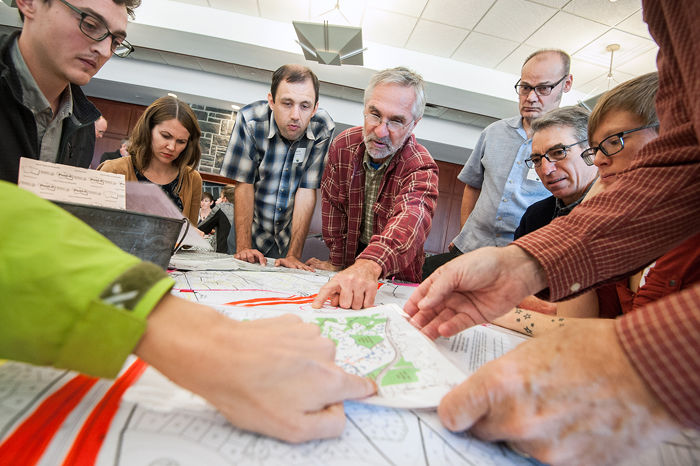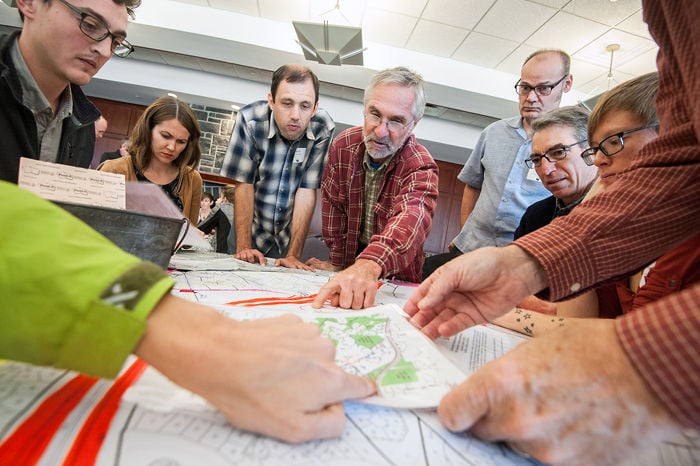2017 Harrisonburg & Rockingham Bike-Walk Summit

Sixth Annual Harrisonburg And Rockingham Bike-Walk Summit Meets
By NOLAN STOUT Daily News-Record Nov 3, 2017

People attending the Harrisonburg and Rockingham Bike-Walk Summit work together to solve designs that are not friendly to pedestrians on Friday in James Madison University’s Montpelier Room. Nikki Fox / DN-R
HARRISONBURG — If you’re afraid to get involved with transportation planning and initiatives because it seems too complicated, try looking at it from a different perspective.
Rather than focus on the complexities and staying out of the process, Fionnuala Quinn says, approach it like remodeling a kitchen.
“When it’s time for your kitchen to be remodeled, you don’t say, ‘Well, I’m not an expert. I don’t know anything about concrete or granite or carpentry, so I’m not going to say anything. In fact, I’m not even going to pay any attention. I’ll just let those kitchen remodeling experts do what’s best for me,’” she said. “That would never happen.”
Quinn spoke to about 90 people, including state and local officials, about public involvement in transportation projects at James Madison University’s Montpelier Room Friday for the sixth annual Harrisonburg and Rockingham Bike-Walk Summit.
The summit is a yearly gathering of elected officials, alternative transportation advocates and Harrisonburg and Rockingham County staff. It is hosted by the Shenandoah Valley Bike Coalition and the Harrisonburg-Rockingham Metropolitan Planning Organization.
The event has jump-started several initiatives in the past few years, including the Connect Our Schools and a study on biking’s affect on the Valley’s economy.
Quinn is a civil engineer and director of Bureau of Good Roads, a nonprofit advocacy group that hosts events, hands-on demonstrations and designs challenges for children and adults to illustrate how road projects come together.
Much of her discussion Friday focused on the need for advocates of pedestrian and bicycle paths. She said it’s become harder to walk places in the past century as roads have been designed for vehicles while ignoring pedestrians.
“What’s become difficult to notice is whether or not someone has [access to] the infrastructure that supports the act of walking,” she said. “Today, we’re in the situation where we have shelves or closets full of shoes, but we may be unable to walk or bike short distances because of what we build and also because of the behaviors we’ve developed in response.
“So, somehow along the way, we’ve kind of forgot that it’s a normal, good thing and that we have the ability to get ourselves places not very far away under our own steam.”
The difficulty with projects is finding the funding and political will to move forward, Quinn said, mostly due to apathy from the public.
Typically, people don’t come to public meetings unless there’s “some level of controversy or they own adjacent property,” she said.
“Public participation is not just learning about what’s planned,” Quinn said. “It’s about having some sort of influence in the decisions.”
The discussion was timely, said organizer Kyle Lawrence, as the city and county begin updating their comprehensive plans. Officials use the plans, which are updated every five years, for long-range planning and land-use decisions.
“It’s the kind of thing that I don’t know has mass appeal,” said Lawrence, president of the Shenandoah Valley Bike Coalition. “Just because you don’t want to study those drawings and maybe make detailed comments on things, doesn’t mean you don’t have a role to play in this process.”
